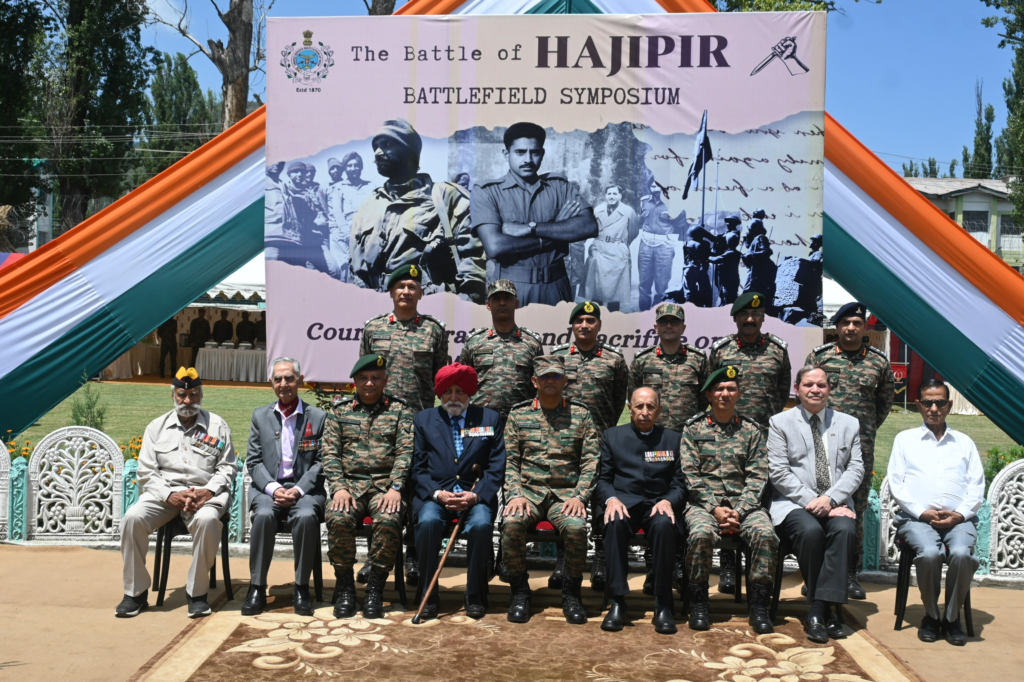
CELEBRATING THE DIAMOND JUBILEE: INDO PAK WAR 1965 SOME LIGHTHEARTED ANECDOTES (Maj Gen Harvijay Singh, SM) Whether apocryphal or real, here are a few anecdotes that add their own ‘Masala’ to the intensity of the battles. The battles will continue till 23 Sep and even beyond, I intend covering more. 1. Pakistan drew up a brazen plan to infiltrate Jammu and Kashmir to induce insurgency and destabilize the region. Operation Gibraltar was launched in August 1965, Pakistan Army soldiers of the Special Services Group (SSG), Mujahids (Muslim warrior) and Razakars (Volunteer Guerrilla), disguised as locals entered the state. Every infiltrating commando was given two rifles and additional ammunition; one to fight with and the second to be distributed to locals to start what was called a – massive indigenous war against Indian occupation; I classify it as belligerence bordering on comical foolhardiness.

2. On the night 6-7 Sep, approximately 180 commandos parachuted into Punjab to sabotage airfields at Pathankot, Adampur, and Halwara. What followed was a grassroots counteroffensive – villagers, NCC cadets, and local police formed search parties. By dawn, 138 were captured and 22 killed. These civilians, armed with little more than farming tools, turned into defenders of national security; band bajaa diyya.
3. Indian troops used sugarcane fields to great advantage in Barki, Asal Uttar and Phillora to execute stealthy “fire and-move”. The natural cover allowed them to advance undetected and surprise the enemy; while the Pattons had superior firepower, the cane had superior concealment.

4. On 6 Sep, as 3 JAT advanced stealthily toward Dograi, a civilian bus—reportedly carrying tourists accidentally entered the operational zone near the Ichhogil Canal. The soldiers, already in combat formation, were stunned to see the bus emerge from the dust. The passengers, equally bewildered, mistook the armed troops for a ceremonial parade. One version claims that Lt Col Hayde, the CO himself signalled the bus to turn back with a mix of stern urgency and humour – one thing is confirmed, Pakistanis were not expecting the 6 Sep offensive.

5. Anna Hazare served as a driver (Sepoy) in the Army Service Corps. He was posted in the Khem Karan Sector during the war, he narrowly survived an air attack. That near-death experience reportedly became a turning point. As per his own account, he took a personal vow to dedicate his life to public service and humanity.

6. During the assault on Barki, a logistics hiccup led to a bizarre situation: one company received crates of pickles instead of ammunition. The jawans, already exhausted and low on supplies, opened the boxes expecting grenades or rifle rounds—only to find jars of mango pickle sloshing around. The quartermaster later admitted the mix-up was due to a mislabelled consignment from a civilian depot. The soldier nicknamed their position “Achaar Post.”

7. During the Battle of Asal Uttar, Pakistanis tanks were abandoned by their crews in great haste or confusion, often still running. Troops reportedly from 4 GRENADIERS and 3 CAVALRY climbed into these tanks, figured out the controls, and drove them back to Indian lines.

8. Brigadier Anthony Albert ‘Tony’ Lumb was commander of 4th Armoured Brigade of Pakistan army). He was commissioned in 9th Royal Deccan HORSE and fought in the World War II with the regiment. After 1947, this regiment was allotted to India. Tony opted for Pakistan army. As destiny would have it, in the Khem Karan sector, Tony was fighting against his old regiment 9 Deccan HORSE of the Indian army

. 9. The Deputy Commissioner of Ambala, MS Gill (former Election Commissioner of India) requisitioned hundreds of civilian trucks with handwritten chits to transport the 4 Mountain Division. The truckers, did not f linch. One driver reportedly asked, “Sir, should I bring back prisoners too, or just drop the soldiers?”
10. While Pakistan got a lot of military aid from America, Pakistani Patton tanks had not carried out any tank firing for over two years as training ammunition provided by Americans was hoarded as ‘war reserve’.

11. 11 Sep soon after dawn, a soldier from 3 CAVALRY (on his morning call) spotted some tanks near Mahmudpura. A team led by 2 Lt PJS Mehta of 3 CAVALRY consisting of two sections of 1 DOGRA (now 7th Battalion the Mechanised Infantry Regiment), was sent to check out. They were greeted by a few dishevelled Paki soldiers coming out of the sugarcane fields and surrendering. They included the CO of Pakistan’s 4 Cavalry, his intelligence officer, two squadron commanders and 16 other ranks; big fish.
12. While 4 HORSE and 17 HORSE advanced towards Phillora, a tank crew found themselves momentarily halted—not by enemy fire, but by a stubborn cow standing squarely in the middle of the road near Libbe village. The tank commander, frustrated but amused, reportedly radioed: “Obstacle ahead. Not hostile. Four legged. Unarmed. Unmoved.” Do you have any anecdote to share? Please do.
